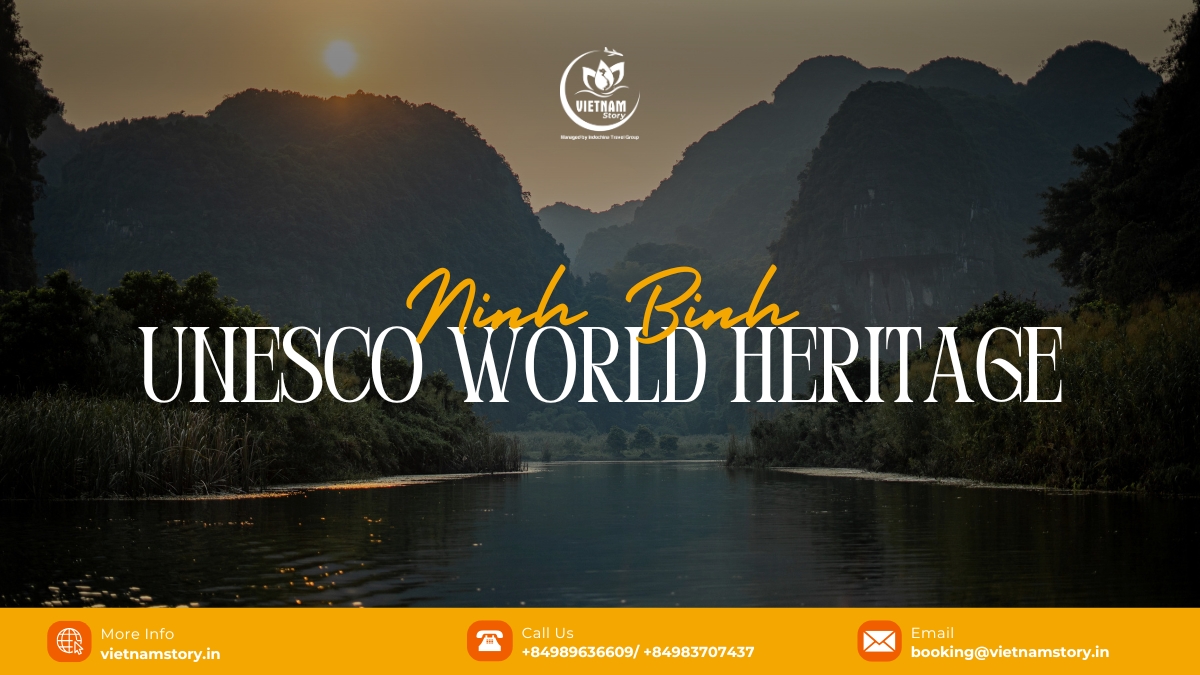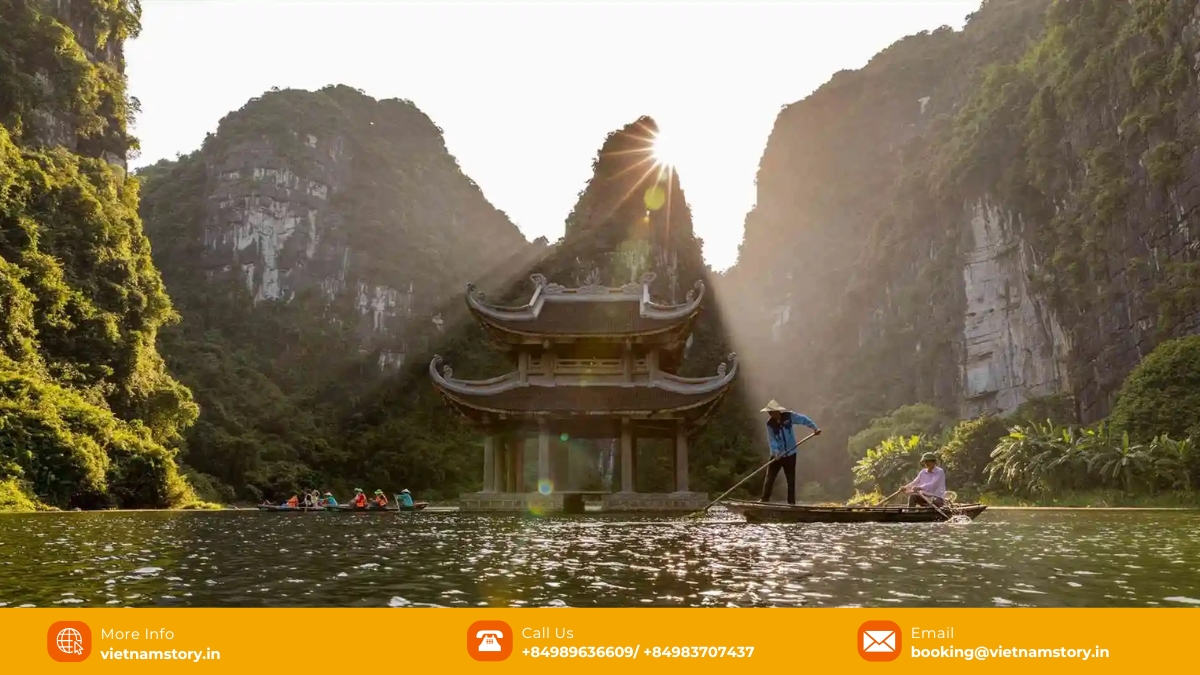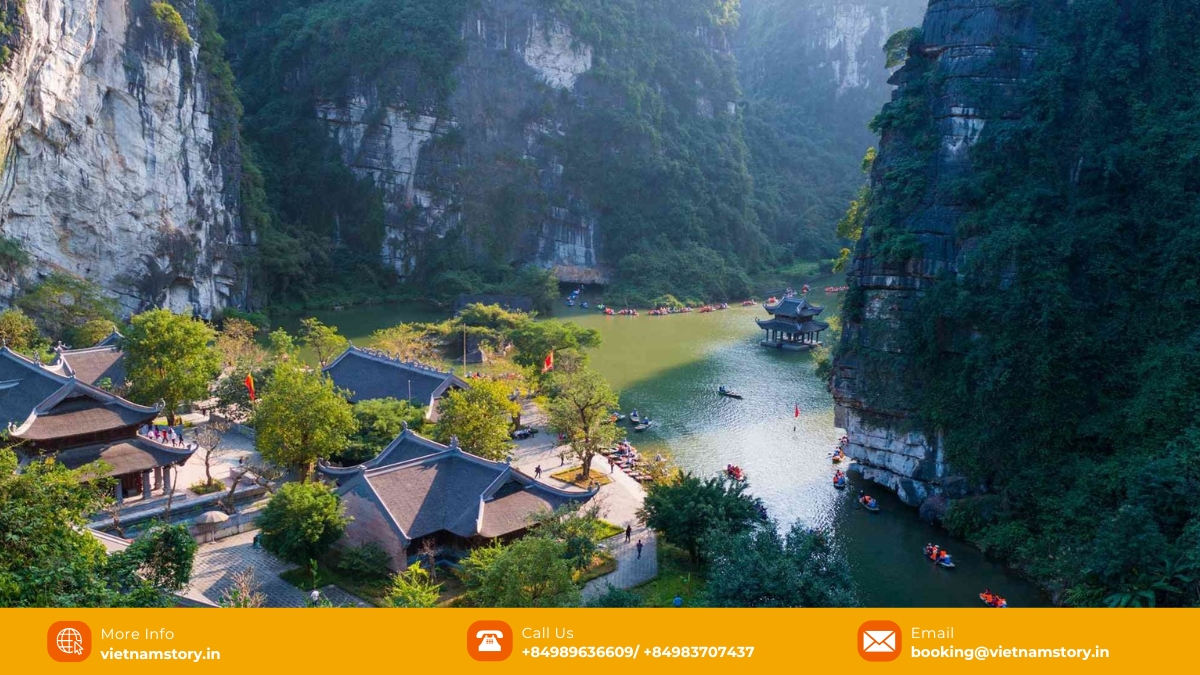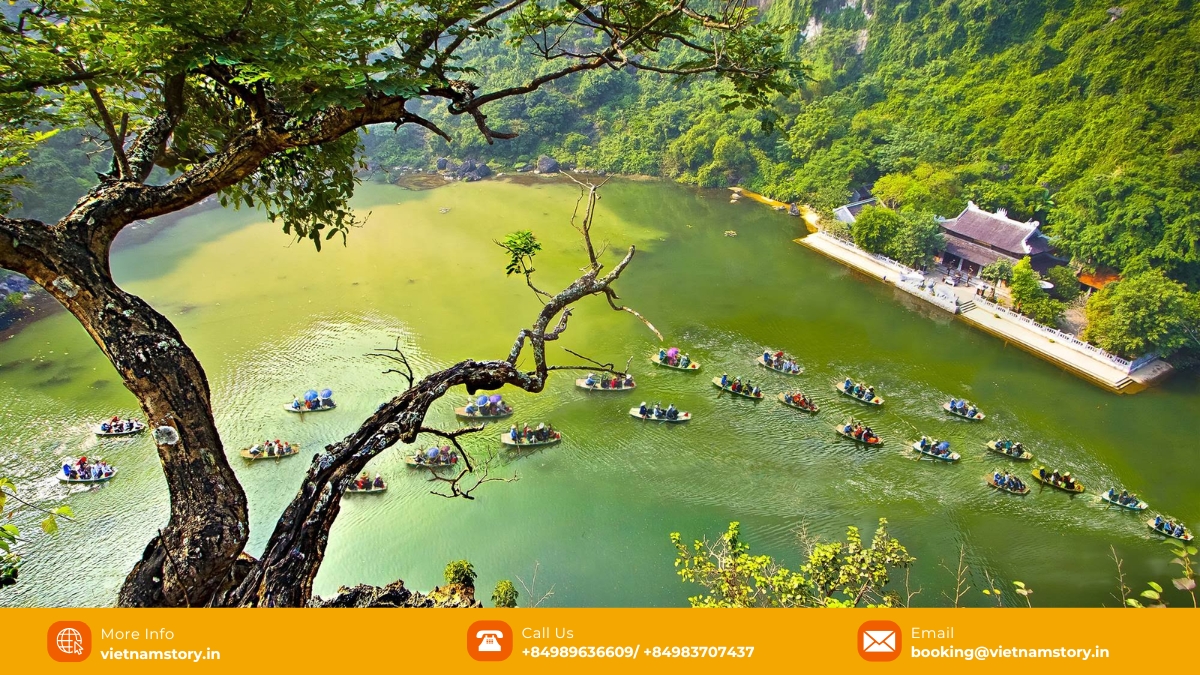After exploring the enchanting rivers of Ninh Binh, we – Vietnamstory are thrilled to take you on a deeper journey into a place that holds global significance – the magnificent Ninh Binh UNESCO World Heritage site. This isn’t just another beautiful spot. It’s a place where the earth tells its ancient stories, and where human history has left an indelible mark, creating a landscape of breathtaking beauty and profound cultural value.
For you, our Indian guests, who come from a land rich in its own UNESCO treasures – from the natural splendor of Kaziranga to the historical grandeur of the Taj Mahal or the ancient cave temples of Ellora – We know that Ninh Binh’s offering will resonate deeply. It’s a place where nature’s artistry and human ingenuity have come together in perfect harmony.
So, let us embark on an exploration of the Trang An Landscape Complex, the heart and soul of the Ninh Binh UNESCO World Heritage recognition.

Why Trang An is a UNESCO-Listed Treasure: The Dual Wonders of Nature and Culture
When we speak of the Ninh Binh UNESCO World Heritage site, we are referring to the Trang An Landscape Complex. Officially inscribed by UNESCO in 2014, Trang An holds a rare distinction: it is Vietnam’s first and only Mixed World Heritage Site. This means it’s recognized not just for its stunning natural beauty, but also for its deep cultural significance and historical value.
This dual recognition is based on several criteria. For nature, UNESCO celebrated its “superlative natural phenomena” and its role as an “outstanding example representing major stages of Earth’s history.” For culture, it was lauded as an “outstanding example of a traditional human settlement” that has adapted to this unique landscape over millennia. It’s this perfect blend that makes the site a living museum.
A. A Landscape of Outstanding Natural Value: The Karst Geology
Prepare to be mesmerized. Often dubbed “Ha Long Bay on Land,” the comparison, while popular, only scratches the surface of Trang An’s unique charm. The most striking feature is the dramatic tower limestone karst landscape. These are limestone mountains, sharply rising from the flat plains and waterways of the Red River Delta, sculpted by geological forces over countless eons.
A network of crystal-clear rivers snakes through these karsts, forming a labyrinth of tranquil waterways and a myriad of submerged caves and grottoes, a testament to its geological importance. This intricate network of waterways is the lifeblood of the region, with each Ninh Binh river telling its own story as it carves through the ancient stone.

The entire area is a biodiversity hotspot, and the karsts are draped in lush vegetation, creating a visual spectacle that feels otherworldly.
B. A Site of Immense Cultural & Historical Significance
Beyond its natural splendor, the complex is steeped in history. The most significant historical component is the Hoa Lu Ancient Capital. In the 10th and 11th centuries, this was the political and cultural heart of Vietnam, serving as the capital under the Dinh Dynasty and the Early Le Dynasty. Nestled amidst the protective embrace of the karsts, its temples stand as sacred sites where Vietnamese people pay homage to their nation’s origins.

Astonishingly, the caves have also revealed evidence of prehistoric human habitation dating back over 30,000 years, a profound link to our distant ancestors. In more recent times, the landscape gained global fame as a major filming location for the movie King Kong: Skull Island, showcasing its cinematic beauty to the world.
The stunning backdrop for the film showcased the raw, prehistoric beauty of the area, solidifying its status as the real-life Kong Skull Island Vietnam and drawing a new wave of international tourists eager to see the epic landscapes for themselves.
READ MORE: Experiencing the majestic Trang An Boat Tour
Planning Your Trip to the Ninh Binh UNESCO Site
A. Getting to Ninh Binh from Hanoi
Located just 90km south of Hanoi, reaching Ninh Binh is straightforward. As the primary travel hub, Hanoi offers several convenient options:
- Private Tour/Driver: The most comfortable and hassle-free option, offering door-to-door service and flexibility.
- Train: A scenic and cost-effective journey of about 2.5 hours from Hanoi Railway Station.
- Bus: The best option for budget-conscious travelers, with many operators running daily routes.
- Motorbike: For the adventurous, offering maximum flexibility to explore at your own pace.
B. Best Time to Visit & Logistics
To make the most of your visit, timing is key.
- Best Seasons: Visit from December to March for cooler, more comfortable weather. For vibrant green or golden rice paddies, the periods of May-June and September-October are ideal, especially for photography.
- Opening Hours: The Trang An ticket office is open daily from 7 AM to 4 PM.
- Pro Tip: Arrive before 8 AM to avoid the largest crowds and experience the serene morning atmosphere.
The Core Experience: The Trang An Sampan Boat Tour
A. Tickets, Price, and Boarding Your Sampan Boat
The boat tour is the quintessential Trang An experience. Tickets are sold at the main office for 250,000 VND per person. A crucial tip: payment must be made in cash (Vietnamese Dong), but an ATM is conveniently located in the parking area. Each traditional sampan boat holds up to four passengers and is expertly rowed by a local guide, who often uses the unique foot-rowing technique, a tradition specific to this region.
B. Choosing Your Route: A Comparison of the Three Journeys
You can choose from three distinct routes, each offering a different perspective of the Ninh Binh UNESCO World Heritage site.
- Route 1 (The Longest Cave Journey): Lasting about 3 hours, this route takes you through 9 different caves and to 3 temples, including Trinh Temple and Tran Temple.
- Route 2 (The Film Lover’s Choice): A 2.5-hour tour that includes 4 caves, 3 temples, and offers a view of the iconic Iwi Village film set from Kong: Skull Island.
- Route 3 (The Royal Route): A 3-hour journey featuring 3 caves, including the magnificent 1-km-long Dot Cave, and a visit to the historic Vu Lam Palace.
Exploring Beyond the Boat: Other Salient Entities in the Complex
While the boat tour is the main attraction, the surrounding area is rich with other must-see sites.
A. Hoa Lu Ancient Capital: Walk Through Vietnamese History
Dedicate a few hours to explore the temples of Emperor Dinh Tien Hoang and Le Dai Hanh. Walking these grounds gives you a tangible connection to Vietnam’s imperial past.
B. Mua Caves (Hang Mua): Climb for the Best Panoramic View
For the most breathtaking panoramic viewpoint, conquer the nearly 500 steps to the top of Mua Caves. The reward is a stunning vista over the entire Tam Coc valley and its river snaking through the karst landscape.
C. Tam Coc – Bich Dong: The Classic Rice Paddy & River Tour
Often explored separately, Tam Coc offers a more rustic boat journey along the Ngo Dong River, famed for the rice paddies that flank its banks. Don’t miss the nearby Bich Dong Pagoda, built into the side of a mountain. The vibrant colors of the Ninh Binh rice fields create a stunning, ever-changing backdrop to the boat journey, painting the landscape in shades of green and gold depending on the season.
D. Bai Dinh Pagoda: A Sprawling Buddhist Complex
A short drive from Trang An, the Bai Dinh Pagoda is a massive spiritual and cultural complex, known as the largest in Vietnam, showcasing the enduring spiritual importance of the region. This complex is a prime example of the region’s spiritual depth, but it is just one of many sacred sites. To fully appreciate the architectural and historical diversity, one can explore each remarkable Ninh Binh pagoda scattered throughout the province.
READ MORE: Top places to visit in Ninh Binh
Practical Tips for a Perfect Visit

To make the most of your visit to this extraordinary site, especially for our Indian guests:
- Embrace Tranquility: The serene landscape offers a meditative experience, much like a peaceful journey on the Ganges or Kerala’s backwaters.
- Cash is King: Remember to bring Vietnamese Dong (VND) for tickets, tips, and small purchases.
- Comfort is Key: Wear light, comfortable clothing and shoes. A sun hat, sunglasses, and sunscreen are crucial.
- Respectful Tourism: This is a protected status site. Dress modestly for temple visits, avoid littering, and keep noise levels down to preserve the peaceful atmosphere.
- Extend Your Compassion: For those interested in ethical wildlife encounters and supporting conservation efforts, a visit to the nearby Bear Sanctuary Ninh Binh offers a meaningful and educational experience.
- Culinary Delights: Ninh Binh offers delicious goat meat dishes and “cơm cháy” (crispy rice). For vegetarian travellers, “cơm chay” (vegetarian rice meal) and various tofu and vegetable dishes are readily available.
READ MORE: Best time to visit Ninh Binh
READ MORE: Top best restaurants Ninh Binh
Conclusion
The Trang An Landscape Complex is more than just a tourist destination; it’s a journey through time, a celebration of nature’s artistry, and a testament to the enduring spirit of human culture. This Ninh Binh UNESCO World Heritage site offers a unique blend of adventure, tranquility, history, and profound beauty that is sure to leave a lasting impression. Its unique fusion of dramatic natural landscapes and deep cultural heritage makes it an unmissable and unforgettable stop on any Vietnam itinerary.
